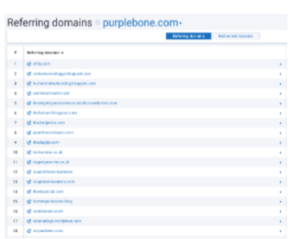In the dynamic world of digital marketing, one cannot afford to underestimate the significance of backlinking. Dive into the realm of backlinks, and unravel the pivotal role they play in bolstering domain authority.

In the ever-competitive business landscape, attracting new customers is an ongoing challenge. You’re likely familiar with the concept of SEO and how it drives targeted traffic to your website by enhancing your search engine rankings. Yet, the world of SEO is intricate, and comprehending every ranking factor can be perplexing, particularly for small business owners aiming to boost their web presence.
All about backlinks:
- So, what exactly are backlinks?
- But why exactly are backlinks so crucial?
- Are There Downsides to Backlinking in Marketing?
- What Constitutes a Valuable Backlink?
Backlinks stand as one of the paramount facets of SEO, as they signal to search engines, particularly Google, that your website carries authority. This becomes especially potent when high-authority domains link to your content. But what exactly is backlinking? Cultivating an effective backlink-building strategy is the linchpin to your success in the competitive arena of search engine results pages (SERPs). The more high-quality backlinks you accrue, the higher you ascend in the search engine rankings.
1.So, what exactly are backlinks?
If you’re somewhat versed in SEO, you might be pondering, “What is a backlink?” In essence, SEO backlinks are hyperlinks from external websites that direct users to your own website. High-quality backlinks hold the power to elevate your search engine rankings and enhance your visibility in search results, ultimately driving more traffic to your site.
Backlinking operates in the realm of off-page SEO, distinct from on-page SEO that focuses on optimizing the content within your website. High-quality backlinks act as endorsements or recommendations from other websites, encouraging visitors to explore your content to gain further insights on specific topics.
In the grand scheme of things, backlinks serve as the litmus test for search engines to gauge the authority and relevance of your website concerning various search queries. Given that Google rewards authoritative content, backlinking becomes an indispensable component of SEO.
2.But why exactly are backlinks so crucial?
Now that we’ve demystified the concept of backlinks, it’s time to grasp their pivotal role. SEO backlinks are instrumental in facilitating website growth in multiple dimensions. To secure a spot on the coveted first page of SERPs, you must distinguish yourself amidst the competition. Unfortunately, most small businesses engage in some form of SEO. However, for many, SEO efforts remain confined to on-page tactics that involve strategically integrating keywords into website content, in a bid to secure higher SERP rankings and augment web traffic.
 Backlinks, in the context of SEO, elevate your rankings by acting as a testament to your website’s authority and garnering trust from other websites. Consequently, the more backlinks your website accumulates, the greater the likelihood of ascending the search engine rankings for specific search terms. While this isn’t an ironclad rule, it can bolster your page rankings for pertinent search queries. Of course, other factors, such as on-page SEO and page loading speed, also contribute to the equation.
Backlinks, in the context of SEO, elevate your rankings by acting as a testament to your website’s authority and garnering trust from other websites. Consequently, the more backlinks your website accumulates, the greater the likelihood of ascending the search engine rankings for specific search terms. While this isn’t an ironclad rule, it can bolster your page rankings for pertinent search queries. Of course, other factors, such as on-page SEO and page loading speed, also contribute to the equation.
Backlinking simplifies the discovery of your website for search engines, enhancing your online visibility. As search engines crawl web content, they often revisit popular pages. Commencing your backlinking journey can expedite the discovery of your content by search engines.
Additionally, backlinks can channel additional website traffic through referral links. Individuals perusing popular websites may stumble upon your backlinks, enticing them to explore relevant content on your website.
Backlinks possess the capability to boost your domain authority. Although domain authority isn’t a direct Google ranking factor, many SEO tools employ this metric to assess your performance vis-à-vis your competitors. An elevated domain authority can bolster your chances of securing top spots on SERPs. Thus, while domain authority doesn’t directly influence rankings, it serves as a valuable yardstick for measuring your progress and fine-tuning your strategies.
Moreover, backlinks amplify your online brand presence. Companies must perpetually invest in brand awareness campaigns to captivate new customers and showcase their latest products and services. By securing backlinks from authoritative websites with substantial monthly traffic, you can augment brand visibility among the visitors of those websites.
While backlinking is a relatively straightforward process, it demands time and strategy. Fortunately, you need not be an SEO virtuoso to embark on a successful backlink-building journey for your website.
3.Are There Downsides to Backlinking in Marketing?
While backlinking is an imperative facet for securing high search engine rankings, it can lead to dire consequences if not executed correctly. Google and other search engines have laid down specific guidelines governing the acquisition of backlinks. Straying from these guidelines can jeopardize your entire SEO strategy and result in a plummet in rankings.
 Excessive backlink building is viewed as spammy by search engines. In the past, marketers exploited the ease of purchasing backlinks for their websites, prompting search engines to clamp down on such spammy practices. Acquiring an abundance of backlinks in a short span may trigger search engines to suspect you’re employing unethical SEO practices, often referred to as black hat tactics. These questionable backlinks, known as toxic backlinks, may share identical anchor text or originate from websites with low trustworthiness.
Excessive backlink building is viewed as spammy by search engines. In the past, marketers exploited the ease of purchasing backlinks for their websites, prompting search engines to clamp down on such spammy practices. Acquiring an abundance of backlinks in a short span may trigger search engines to suspect you’re employing unethical SEO practices, often referred to as black hat tactics. These questionable backlinks, known as toxic backlinks, may share identical anchor text or originate from websites with low trustworthiness.
Furthermore, while SEO backlinks wield substantial influence on rankings, they aren’t the sole determinant. Devoting excessive time to backlink acquisition at the expense of crafting quality content that aligns with user intent and incorporates strategic keywords can hinder your web pages from ranking for their target keywords.
Backlinking also devours time, and those venturing into it independently often encounter numerous low-quality websites. Associating with such websites can paradoxically hamper your rankings. Small businesses are better off focusing their energy on securing high-quality backlinks instead of fixating solely on quantity, as is often seen with top-ranking pages.
4.What Constitutes a Valuable Backlink?
In a sea of good and bad backlinks, understanding the characteristics of a valuable backlink can guide you in formulating an effective backlinking strategy. The most coveted backlinks are those that are relevant, authoritative, and drive referral traffic to your site.
Relevance should be at the forefront of your considerations. Your backlinks ought to reside on websites or pages that resonate with the content you’re sharing. For instance, if you deal in dog products, scouting for backlink opportunities on dog-related blogs makes more sense than targeting beauty blogs. Not only do these backlinks align with your niche, but readers of such blogs are more likely to click through to your website.
Authority is another crucial criterion, as backlinks from high-authority sites hold greater weight and confer their authority onto your web pages. However, it’s worth noting that authority gets distributed among all the backlinks on a given webpage. High-authority websites don’t always correlate with high traffic, though traffic remains a noteworthy factor. Websites with substantial traffic are more likely to channel referral traffic to your page, although this doesn’t necessarily impact rankings.
 The type of backlink matters as well, and there are two categories to consider: dofollow and nofollow links. Dofollow backlinks exert a more pronounced influence on rankings compared to nofollow links, though the latter can still transmit some authority. Consequently, prioritizing dofollow links can optimize your backlinking strategy for enhanced rankings.
The type of backlink matters as well, and there are two categories to consider: dofollow and nofollow links. Dofollow backlinks exert a more pronounced influence on rankings compared to nofollow links, though the latter can still transmit some authority. Consequently, prioritizing dofollow links can optimize your backlinking strategy for enhanced rankings.
In addition to these factors, pay heed to the anchor text employed for your backlinks. Anchor text denotes the hyperlinked text containing the URL to your website. Contrary to popular belief, you can’t employ any anchor text for your backlinks. Keyword-rich anchor text can trigger alarms with Google and other search engines, as they may interpret it as an attempt to manipulate rankings rather than offer relevant and valuable content. Opting for natural, contextually fitting anchor text is the prudent choice.
In essence, backlinking serves a singular purpose: elevating website traffic by bolstering your rankings in SERPs. However, it’s crucial to remember that backlinks should not be an end in themselves. Rather, view them as conduits to drive site traffic and enhance your visibility on search engines, with the ultimate goal of delivering valuable content. Measuring the impact of your campaigns can aid in identifying which backlinks yield the most traffic, enabling you to refine your strategy accordingly.
Remember to incorporate external links as part of your SEO strategy. Beyond the two well-known link types, backlinks and internal links, there exists a third dimension: external links. These links occur when your website directs users to other websites. While it may seem counterintuitive, as it appears to divert visitors away from your page, external links can yield substantial SEO benefits.
External links can fortify your credibility by allowing you to cite sources and provide references, helping search engines evaluate the relevance and usefulness of your pages.
Our “A Comprehensive Guide to Mastering Backlink Analysis” will help you learn more about the world of backlinks.
A Comprehensive Guide to Mastering Backlink Analysis
Backlink Analysis Demystified
Backlink analysis is akin to the SEO realm’s regular check-up, ensuring your website’s overall health. It’s not just a routine task but becomes especially vital when you sense something amiss in your site’s performance.

This meticulous process serves as a diagnostic tool to evaluate your website’s well-being and to pinpoint any issues that might be sabotaging your search engine rankings. Whether you’ve detected a sudden plummet in your site’s ranking or are merely dissatisfied with your progress, a backlink analysis offers a much-needed prognosis.
Beyond assessing your website’s condition, a backlink analysis unveils how you stack up against your competitors. It’s akin to discovering the strategies your rivals employ and extracting insights for improving your own tactics.
Lastly, it opens doors to uncharted growth opportunities you might not have explored before.
Step 1: Handpick Your Sites for Analysis
While it’s evident you’ll scrutinize your own website, it’s equally important to narrow down the list of competitor sites you intend to investigate. You might have some contenders in mind already, but if not, prioritize sites that:
- Offer similar products or services.
- Currently outrank you for your target keywords.
Step 2: Choose Your Analysis Tool
While manual backlink audits are possible, using a dedicated backlink tool is usually more efficient, as it encompasses the essential features you need.
Numerous backlink checker tools are available, with varying prices and capabilities. Typically, these tools are embedded within broader SEO suites like Majestic and SEMrush.
If you’re seeking recommendations for a suitable backlink analysis tool, you can find some suggestions here.
Step 3: Initiate the Preliminary Assessment
Once you’ve selected your analysis tool, it’s time to commence the evaluation. Input your domain name into the search bar and scrutinize the results.
You’ll be greeted with a deluge of data. To quickly gauge your site’s performance, concentrate on these key metrics:
-
- Total Backlinks: The number of links directed to your site. For example, if website A creates a blog post and links to a page on website B, that counts as a backlink. A low count here might be hindering your rankings.

- Referring Domains: The number of distinct websites pointing to your site. Each website linking to yours constitutes one referring domain. Sorting these domains by authority helps gauge their contribution to your ranking and provides outreach ideas.
- Top Linked Pages: The pages on your site receiving the most backlinks. This indicates the type of content conducive to link building.
Repeat this process for your competitors to establish a benchmark and identify your position relative to theirs. Some tools allow you to compare these metrics simultaneously, eliminating the need for constant switching.
Step 4: Delve into the Details
Now, it’s time to delve into the finer details and address the “why” behind your site’s performance.
Begin by examining your anchor texts – the words used to hyperlink to your webpage. This is an effective way to spot spammy backlinks that could be detrimental to your ranking. If the anchor text appears unrelated or resembles email spam, it’s likely spam.
 Once identified, you have two options: reach out to the linking websites for removal (a long shot) or disavow the links, effectively instructing Google to disregard them.
Once identified, you have two options: reach out to the linking websites for removal (a long shot) or disavow the links, effectively instructing Google to disregard them.
Another aspect to scrutinize is your country code top-level domain (ccTLD) distribution. The ccTLD is the portion of a URL that designates its country of origin. This can help identify websites potentially causing negative SEO (i.e., malicious practices aiming to harm your ranking). For example, if your site receives substantial traffic from Haiti, .ht backlinks are expected. However, unfamiliar TLDs like .cn might warrant further investigation.
Next up: broken or lost links. Identifying these is crucial as they deprive you of “link juice” and complicate your site’s crawlability. Remedying this involves:
-
-
- Contacting the referring domain to request a fix.
- Redirecting the broken page to a new one on your site.
- Redirecting the broken page to another page with similar content.
-
Step 5: Analyze Competitor Strategies
As you dive deeper into your domain, ensure you compare your findings with those of your competitors. Examine the referring domains of the website outranking you. If your list substantially differs from theirs, it could provide insights into potential domains to target. Also, compare your backlink acquisition rate with your competitors – if they’re growing significantly faster, it’s a cue to explore that avenue further.
Author
-

Alisha is the Editor-in-Chief of Search Engine Journal. Before that, she covered tech for News & Trends, content editing, and social strategy at AdClickAgency. Alisha holds a BA in English and Journalism from Mount Holyoke College and an MBA in Marketing from San Francisco State University. Her work has also appeared in Thrillist, the Boston Herald, and EcoSalon, and she's based in St. Petersburg, Florida.
View all posts







